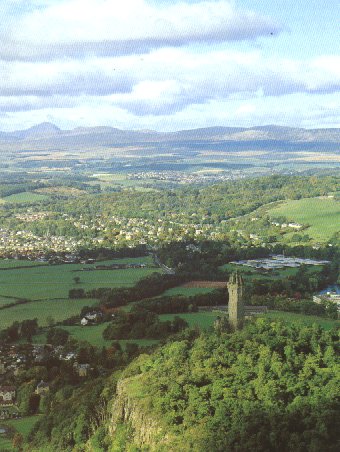


Bridge of Allan is a charming little village nestling by the Allan Water. Overlooked by the National Wallace Monument, a towering tribute to Scotland's greatest freedom fighter, Sir William Wallace and by Stirling's imposing cliff-top castle. The village with its fine Victorian buildings and long standing reputation as a popular holiday destination has much to offer visitors. Come and discover Bridge of Allan.
Bridge of Allan is situated on and below the slopes of the westernmost portion of the beautiful Ochil Hills, just before they dwindle into the Dunbiane gap to the west, less than three miles, from the centre of Stirling. The first small settlement sprang up around a cornmill close to the bridge by the Allan Water.
On the slopes of the Ochil Hills above, copper was mined as early as the 16th century and at intervals thereafter right up to 1815. The main adit (entrance shaft) of the mine can still be seen today in the woodlands. The mine was worked by the villagers of another small community, formerly known as Pathfoot, on the Airthrey estate. In 1820, this estate was in the hands of Sir Robert Abercrombie. He was well informed on the fashion for visiting spas for health reasons and equally aware of the growing numbers of visitors in the vicinity, thanks to the writings of Sir Walter Scott, whose 'The Lady of the Lake' brought the Trossachs to a wide audience only a decade before.
Sir Robert therefore decided to have the waters, springing from the area of the shaft, analysed. Following a favourable report on their curative properties he tidied up around the mine. Below it, a Well House was built soon afterwards (now gone) and the nearby Spa Pump Room can be seen today as Kipling's Restaurant, in Mine Road. As early as 1836, Tait's Edinburgh Magazine described Bridge of Allan as a 'small watering place, a delightful summer weekend retreat'. Certainly, the town had arrived.......
In 1844 the estate was bought by the equally energetic Major Henderson of Westenton. He set a grand expansion plan in motion. This period of prosperity resulted in much of the fine Victorian architecture seen today in both public buildings and private residences, although many of these were originally built as guest houses for those taking the waters.
In 1846, the railway first arrived in Bridge of Allan, further accelerating its development. A reading room, library and bowling green were among the facilities enjoyed by the Victorian visitors. Their routine revolved around the wells in the early morning, where the regime recommended drinking four pint tumblers, then spending the rest of the day enjoying local activities such as walks, drives and angling.
Major Henderson's efforts in turning Bridge of Allan into a highly fashionable spa resort are recalled today in the main street, Henderson Street, and in such features as the Fountain of Nineveh (Fountain Road), complete with its cast iron Doric column. This was an 1851 whimsy of the Major which was named to commemorate the excavations going on at the time at the site of the original Nineveh (on the River Tigris in modern day Iraq).
Other interesting buildings springing from that time include the Museum Hall (now closed) with its arcades and Italian influenced palazzo styling, and also the 1860 Holy Trinity Church, now celebrated for the elegant furnishings added in 1904 by internationally acclaimed Scots architect, Charles Rennie Mackintosh.
Among the visitors to Bridge of Allan in its Victorian heyday were the Stevensons, from the famous lighthouse engineering family. The young Robert Louis Stevenson, who became perhaps the black sheep of the family by becoming a novelist, is also associated with a little cave on the Allan Water. The Stevensons spent many holidays in Bridge of Allan, the first when Robert Louis was only two years old. A plaque in the Royal Hotel, in Henderson Street, recalls one of his stays there.
Today, there is still a wide choice of accommodation in Bridge of Allan, from hotels to smaller guest houses. Bridge of Allan is still on a main rail link north of Stirling and only one mile from the main road network of central Scotland. This Puller Memorial Park makes Bridge of Allan an excellent, relaxing base from which to explore the historic attractions of Royal Stirling and Scotland's other main towns and cities. Edinburgh, Glasgow and Perth are all within one hour's travel time. What's more, the magnificent scenery of the Trossachs, Loch Lomond and much of the Highlands is also within easy reach.
A variety of shopping is available from specialist suppliers, such as wood furnishings, classic poultry, glass and tapestry experts, outdoor pursuits, as well as second-hand books and an award-winning delicatessen. There is also a wide choice of eating places for light meals and casual snacks, as well as a Ia carte dining.
There are also several fine walks in the vicinity - see Darn Road and University of Stirling opposite. The woodlands (Mine Woods) above Bridge of Allan offer a number of walks, including a picturesque and sheltered pathway, with views across to Stirling, which passes by the old mineshaft, to which Bridge of Allan owes so much for the Victorian heritage seen today.
With its excellent shopping, handsome Victorian buildings and a warm welcome at any of the local hostelries it is evident why Bridge of Allan is a natural choice for a holiday or day visit.
Click on the logo below to validate this document as HTML 4.0


![]() For personal mail,
you can get me here
[email protected]
For personal mail,
you can get me here
[email protected]